
Epitaph
Epitaph
ep·i·taph [ˈepəˌtaf]
- 25 minutes 33 secondsBela Kiss, the Vampire of Czinkota
Subscribe on your favorite podcast catcher:
Apple Podcasts | Android | CastBox | Google Podcasts | PocketCasts | PodBean | Stitcher | RadioPublic | TuneIn | Blubrry | RSSIn May of 1916, Martin Greschinsky arrived at his rental property at 9 Kossuth Street in the small, vacation town of Czinkota, Hungary just outside of Budapest to clean it out and see if any repairs needed to be made before it could be rented out again.
His tenant had been killed in World War I.
But, when Greschinsky pried open what he believed was a barrel of gasoline, he was met with the face of a woman who’d been dead for several years, perfectly preserved in wood alcohol.
As more and more bodies were discovered, detectives determined that they were dealing with a serial killer who’d preyed on wealthy women and who, even after death, managed to stay one step ahead of them and evade capture for decades.
On this episode, we discuss the gruesome crimes of the man who’d become known as the Vampire of Czinkota, Bela Kiss.





Photos:
(1) Bela Kiss, taken circa 1914. (Source: Miami News – August 31, 1930)
(2) Katherine Varga, a dressmaker from Budapest who disappeared in 1912. (Source: New York Daily News – February 9, 2014)
(3) Margaret Toth, who disappeared in 1904 after her mother received a letter claiming that Kiss had broken off their engagement and, heartbroken, she was leaving for America. (Source: New York Daily News – February 9, 2014)
(4) The house (on left) that Kiss rented in Czinkota (Source: New York Daily News – February 9, 2014)
(5) The barrels and trunk in which the first bodies and clothing were found (Source: New York Daily News – February 9, 2014)Suggested Reading
- The Seven Tin Barrels – In the Footsteps of the First Hungarian Serial Killer by Zsolt Viktor Maróti on Újkor.hu
This page is where information on Bela Kiss’s “first wife,” Julia Peschadik, who is referenced on his Wikipedia entry can be found. It indicates that she had given their two children to the White Cross before moving to Czinkota to be with Kiss, and was later found in one of the barrels (specifically, the one on the far right in the photo above). It is entirely possible that this information — and, with it, the information on Wikipedia that I’ve questioned — is correct. But, I’ve been unable to find other sources to corroborate it and Julia Peschadik’s name does not appear in contemporaneous newspaper accounts that document Kiss’s victims. - When Cinkota was on the cover of the world press on The cloud above me
Warning: This page includes photos not only of the barrels and of the detectives opening them, but of several of the victims pulled from the barrels. - The Crimes of Bela Kiss by Marilyn Bardsley and Denise Noe on CrimeLibrary.com (via Archive.org)
14 November 2019, 2:00 pm - The Seven Tin Barrels – In the Footsteps of the First Hungarian Serial Killer by Zsolt Viktor Maróti on Újkor.hu
- 27 minutes 13 secondsThe Vampires of Eastern Europe
Subscribe on your favorite podcast catcher:
Apple Podcasts | Android | CastBox | Google Podcasts | PocketCasts | PodBean | Stitcher | RadioPublic | TuneIn | Blubrry | RSSThe mythology of the vampire dates back millennia.
As early as 4,000 BC, the Sumerians and Babylonians had stories about those who’d not been buried properly returning to suck life out of the living. Ancient Mesopotamians had stories of the Lamastu, a female demon who appeared at night to steal or kill babies, and sucked the blood from adults.
In 2018, archaeologists found the remains of a 10-year-old child buried in a 4th Century Roman cemetery in Umbria, Italy that had been buried with a stone the size of an egg inserted — and then cemented — into its mouth to prevent it rising from the dead and harming the living. Locals call it the “Vampire of Lugnano.”
Nothing has survived that tells us anything about these burials. We don’t know who these people were and we can only guess at why they’d died.
But, in the 16th and 17th centuries, in the mountains of southeastern Europe, these sorts of legends — stories of the dead who’d come back to harm and kill the living — started having names attached.
These stories — and the legends and beliefs that fed them — would become the folklore for the creatures that we know as Vampires today.
In this episode, we begin our exploration of “real vampires” with the stories of three of these men — Giure Grando, Petar Blagojevic, and Arnod Paole — and, when possible, those that became their victims.
This is no romancer’s dream. It is a succinct account of a superstition, which to this day survives in the east of Europe where little more than a century ago it was frightfully prevalent. At that period, Vampyrism spread like a pestilence through Servia and Wallachia, causing numerous deaths, and disturbing all the land with fear of the mysterious visitation, against which no one felt himself secure.
Dr. Herbert Mayo, in “Letters on the truths contained in popular superstitions” (1849)
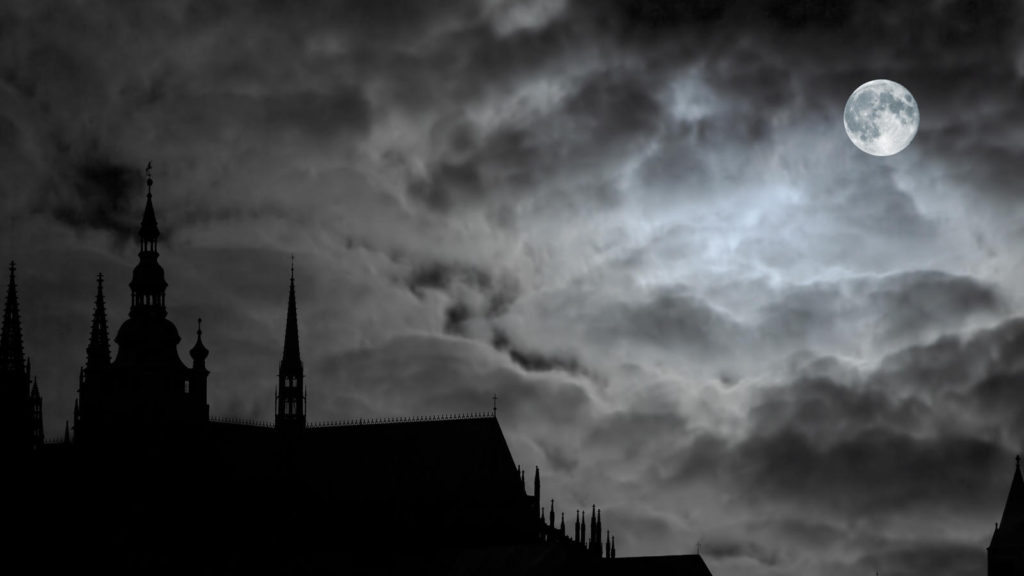
Suggested Reading
- Valvasor on Vampires from Shroudeater.com
- A letter from the Gradisker District by Austrian physician Frombold, sent to the Emperor of Kisolova in 1725.
- Visum et repertum by Johann Flückinger, written in 1732. (A translation of the original document at VampGirl.com, and retrieved via Archive.org)
- Treatise on the Apparitions of Spirits and on Vampires or Revenants of Hungary, Moravia, et. al. at Wikipedia
- Visum et repertum by Niels K. Petersen on Magia Posthuma
- Archaeologists find ‘vampire burial’ site of a child feared capable of rising from the dead from the Washington Post
- Vampires: Fact, Fiction and Folklore by Benjamin Radford at LiveScience.com
1 November 2019, 1:00 am - 42 minutes 46 secondsResurrection Mary, Part 4: Mary Kovac
Subscribe on your favorite podcast catcher:
Apple Podcasts | Android | CastBox | Google Podcasts | PocketCasts | PodBean | Stitcher | RadioPublic | TuneIn | Blubrry | RSSResurrection Mary is one of Chicago‘s most famous ghosts.
And, having been featured on paranormal shows like Unsolved Mysteries, In Search Of, and Arthur C. Clarke’s World of Strange Powers, she might just be the most famous Vanishing Hitchhiker in the world.
Jerry Palus is said to have been, perhaps, the first person to have met the ghost who’d become known as Resurrection Mary face to face back in 1939.
At the Liberty Grove and Hall, a ballroom near 47th and Mozart, Palus saw a beautiful, young, blonde woman without a dance partner and decided to take a chance on asking her to dance. They spent the evening together, dancing and talking until the ballroom closed.
Jerry offered her a ride home but she didn’t ask to go to the address on Damen Avenue where she’d told him she lived earlier in the evening. Instead, she asked him to drive out Archer Avenue.
And, as they approached Resurrection Cemetery, she asked him to pull over.
According to Palus, Mary told him that that’s where she had to get out and, where she was going, he couldn’t follow. And, then, she crossed the street and vanished as she approached the cemetery gates.
For decades, people fascinated with the story have been trying to answer the question: Who was she?
Over the years, a number of “candidates” have been put forth. And, in researching the history of the legend and the community it came from, we found one of our own: Mary Kovac.
She grew up in the same immigrant community on Damen Avenue as two other young women commonly associated with the Resurrection Mary legend, going to school and church with both Mary Mizkowski and Mary Bregovy.
She fit the same descriptions that were given of Mary Mizkowski.
And, her cause of death fits that of the “third girl” that Richard T. Crowe often referred to and, because of that, we think that he may have actually identified this Mary himself.
On this episode, we present the story of Mary Kovac who, we believe, may have been the young woman whose ghost Jerry Palus met at the Liberty Grove and Hall in 1939: The original Resurrection Mary.
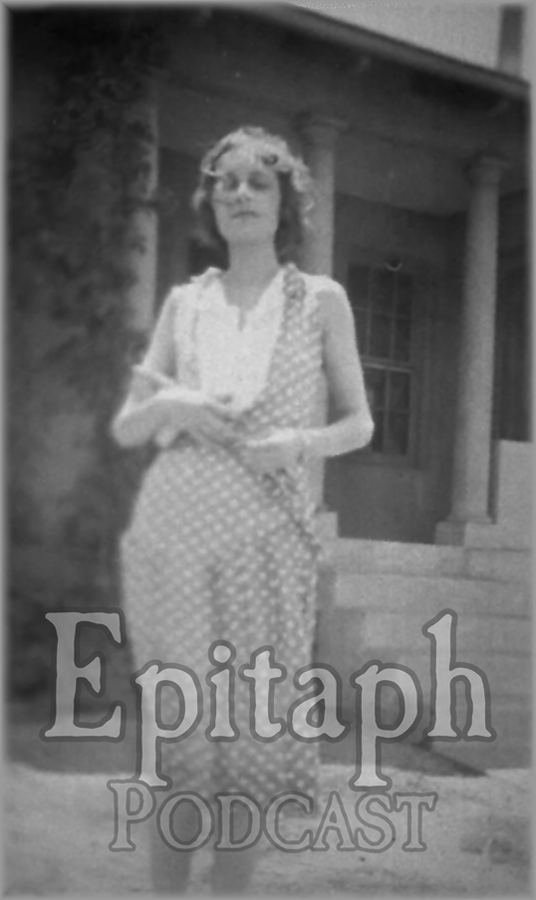
Photo: Mary Kovac, circa 1930.
(Reuse or reproduction of any part of this photo without express written permission from Epitaph is prohibited.)Our Other Podcasts in this Series
- Resurrection Mary, Part 1: Mary Miskowski (Patreon Exclusive)
- Resurrection Mary, Part 2: Mary Bregovy
- Resurrection Mary, Part 3: Anna Marija Norkus (Patreon Exclusive)
Suggested Reading
- Chicago’s Street Guide to the Supernatural: A Guide to Haunted and Legendary Places in and near the Windy City by Richard T. Crowe
Other Suggested Podcasts on This Story
- Ep 102: Resurrection Mary Part 1 by Astonishing Legends
- Ep 103: Resurrection Mary Part 2 by Astonishing Legends
- Ep 104: Resurrection Mary Part 3 by Astonishing Legends
- Ep 105: Resurrection Mary Part 4 by Astonishing Legends
- Resurrection Mary Roundtable by Chicago Unbelievable
Audio Excerpt Credits
Audio from interviews with Richard T. Crowe appears with the written permission of his family and his estate. Audio from interviews with Jerry Palus appears with the written permission of his family and his estate. Epitaph makes no claims of ownership to this audio.
28 May 2019, 1:00 pm - 9 minutes 39 secondsResurrection Mary, Part 2: Mary Bregovy
Subscribe on your favorite podcast catcher:
Apple Podcasts | Android | CastBox | Google Podcasts | PocketCasts | PodBean | Stitcher | RadioPublic | TuneIn | Blubrry | RSSResurrection Mary is one of Chicago‘s most famous ghosts.
And, having been featured on paranormal shows like Unsolved Mysteries, In Search Of, and Arthur C. Clarke’s World of Strange Powers, she might just be the most famous Vanishing Hitchhiker in the world.
For decades, people fascinated with the story have been trying to answer the question: Who was she?
And, over the years, a number of “candidates” have been put forth.
Mary Bregovy was the daughter of Czechoslovakian immigrants who died in a car crash after a night at the Oh Henry Ballroom in the 1930s. And, like the girl in the Resurrection Mary legend, she had lived on Damen Avenue.
But, despite people who knew her while she was alive having reported seeing her on Archer Avenue after her death, Mary Bregovy didn’t look like the girl who is normally described in Resurrection Mary sightings.
On this episode, we discuss how she fits into the Resurrection Mary legend.
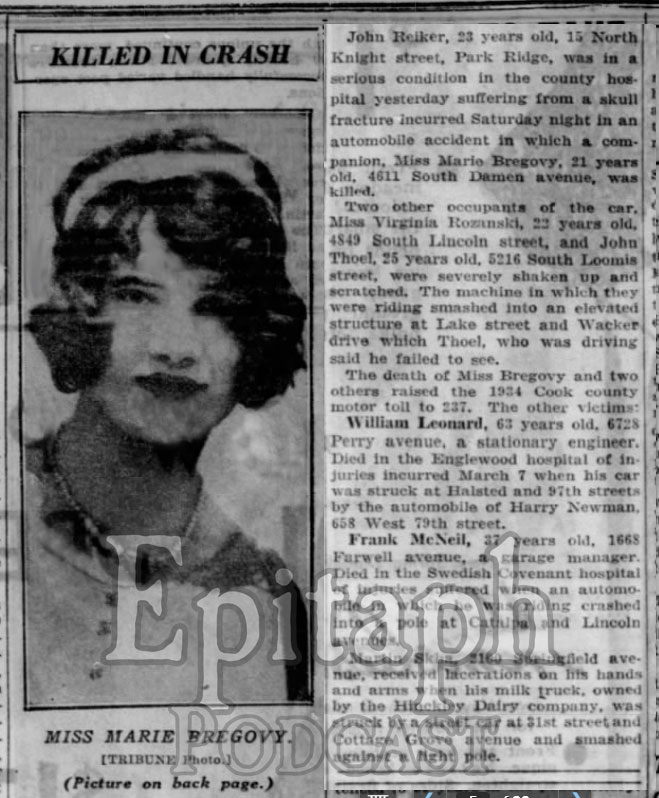
Article: Chicago Tribune article from March 12, 1934 describing the accident which killed Mary Bregovy (Source: Newspapers.com).
Our Other Podcasts on This Story
- Resurrection Mary, Part 1: Mary Miskowski (Patreon Exclusive)
- Resurrection Mary, Part 3: Anna Marija Norkus (Patreon Exclusive)
- Resurrection Mary, Part 4: Mary Kovac
Suggested Reading
- The Ghosts of Chicago: The Windy City’s Most Famous Haunts by Adam Selzer
- Chicago’s Street Guide to the Supernatural: A Guide to Haunted and Legendary Places in and near the Windy City by Richard T. Crowe
Other Suggested Podcasts on This Story
- Ep 102: Resurrection Mary Part 1 by Astonishing Legends
- Ep 103: Resurrection Mary Part 2 by Astonishing Legends
- Ep 104: Resurrection Mary Part 3 by Astonishing Legends
- Ep 105: Resurrection Mary Part 4 by Astonishing Legends
- Resurrection Mary Roundtable by Chicago Unbelievable
Additional Resources
- The Last Dance of Mary Bregovy by Troy Taylor at American Hauntings
- Resurrection Mary: The Queen of Chicago’s Haunted Archer Avenue by Ursula Bielski at ChicagoHauntings.com
- Resurrection Mary: Mary Bregovy? by Adam Selzer at Mysterious Chicago
- Possibly the “most loved” Ghost in Chicagoland by Raymond Johnson at Chicago’s Haunt Detective
14 May 2019, 1:00 pm - 39 minutes 12 secondsThe Waldheim Flapper
Subscribe on your favorite podcast catcher:
Apple Podcasts | Android | CastBox | Google Podcasts | PocketCasts | PodBean | Stitcher | RadioPublic | TuneIn | Blubrry | RSSChicago’s most famous Vanishing Hitchhiker is, without a doubt, the ghost of the young woman (or women) who has come to be called Resurrection Mary. But, Mary isn’t Chicago’s only hitchhiking spirit and her story is pre-dated by another ghost: The Waldheim Flapper.
In some ways, their stories parallel each other.
Mary haunts the stretch of Archer Avenue between the old Willowbrook Ballroom and Resurrection Cemetery, while the Waldheim Flapper was associated with Des Plaines Avenue between the Melody Mill Ballroom and Waldheim Jewish Cemetery.
Both girls are thought to have come from communities of Eastern European immigrants.
And, both represent important eras in Chicago history. The Flapper comes from the Roaring Twenties, an era known for prohibition, gangland violence and progressive social change. Mary comes from the 1930s, the decade not only of big bands and ballroom dancing, but also the Great Depression.
In other ways, the girls in the story seem opposites.
Where Resurrection Mary is a Catholic girl with long, blonde hair and a white gown, the Waldheim Flapper is Jewish, with short, dark curls and — as the name implies — a straight-waisted, knee-length, fringed flapper dress straight out of the 1920s.
Together, they were two of the most commonly reported ghosts in Chicago.
On this episode, we explore the story of Chicago’s other vanishing hitchhiker: The Waldheim Flapper.
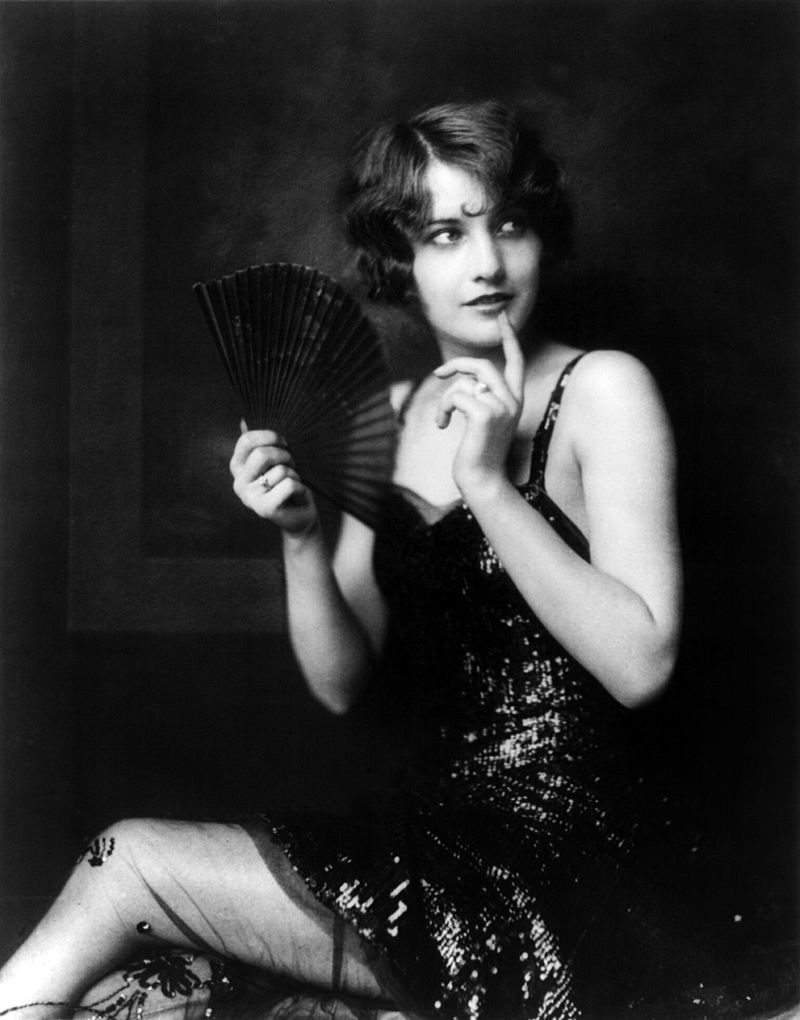
Barbara Stanwyck as a Ziegfeld girl (c. 1924) by Alfred Cheney Johnson (Source: Wikipedia Commons | Library of Congress)
Suggested Reading
- Chicago’s Street Guide to the Supernatural: A Guide to Haunted and Legendary Places in and near the Windy City by Richard T. Crowe
- The Ghosts of Chicago: The Windy City’s Most Famous Haunts by Adam Selzer
- Just Kill Me by Adam Selzer
- Chicago Haunts: Ghostlore of the Windy City by Ursula Bielski
Additional Resources
- Posts about Lillian Collier by Adam Selzer at Mysterious Chicago Tours
- Jewish Waldheim Cemetery by Dale Kaczmarek at the Ghost Research Society
- Chicago’s Other Vanishing Hitchhikers by Troy Taylor at PrairieGhosts.com
- Chicago’s Flapper Ghost of the Roaring Twenties by Marlon Heimerl at Legends of America
Music
- Moonlight on Melody Mill by Bobby Freeman, Cramer and Tiny Hill and his Orchestra at Internet Archive (archive.org)
If you’re enjoying Epitaph, please consider becoming a Patreon patron.
 1 May 2019, 1:00 am
1 May 2019, 1:00 am - 16 minutes 29 secondsBonus: The Uniondale Hitchhiker
Subscribe on your favorite podcast catcher:
Apple Podcasts | Android | CastBox | Google Podcasts | PocketCasts | PodBean | Stitcher | RadioPublic | TuneIn | Blubrry | RSSBetween the towns of Uniondale and Willowmore in the Western Cape, drivers and motorcycle riders have reported encounters with one of South Africa’s most famous ghosts.
With many of our stories this season, we pick out the unique details and see where they fit with local history.
We scour old newspapers, historical records and genealogical information to see if the legend is based on fact.
This story is different.
With this story, the identity of the victim is well-known to locals.
Witnesses have been interviewed by police and newspaper reporters. In one case, one of the policemen involved even witnessed it himself.
And, what has resulted is one of the most enduring and well-documented versions of an otherwise familiar urban legend: the Uniondale Hitchhiker.

Photo: The road between Willowmore and Uniondale (Source: My Cradock | Wikimedia Commons).
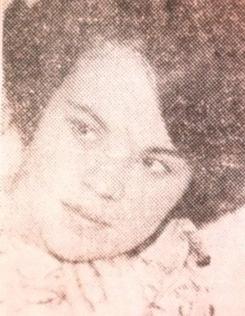
Maria Roux, a student nurse, was travelling to Riversdale with her fiancee, Michiel “Giel” Pretorius.
In the early morning hours of Good Friday (April 12), 1968, Giel lost control of the vehicle and Maria, who was asleep in the passenger seat, was killed instantly.
But, some say she is still trying to get home.
Additional Resources
- Maria Charlotte Roux at Geni.com
- Roux, Ria 1945-1968 at Genealogical Society of South Africa
- Uniondale Phantom Hitchhiker by Ian at Mysterious Britain and Ireland
- The Ghost of Unionale by Elaina J. Davidson at Bards and Tales.
- 10 of my Favorite Haunted Places in South Africa by Mariza at Caffeine and Fairy Dust
If you’re enjoying Epitaph, please consider becoming a Patreon patron.
16 April 2019, 1:00 pm - 18 minutes 38 secondsBonus: The Murdered Girl on Wilfred Barrett Drive
Subscribe on your favorite podcast catcher:
Apple Podcasts | Android | CastBox | Google Podcasts | PocketCasts | PodBean | Stitcher | RadioPublic | TuneIn | Blubrry | RSSThe plot of the story is like something out of a bad horror movie.
A girl walking home alone along Wilfred Barrett Drive, is brutally assaulted, raped, and left for dead by a group of men on Jenny Dixon Beach on the Central Coast of New South Wales, Australia.
The men are never arrested for the crimes but, after the girl dies from the injuries they’d inflicted, her attackers begin dying under mysterious circumstances.
The first hangs himself after telling his friends that he’s seeing visions of the girl they’d killed.
The next is in a fatal car wreck after seeing the girl appear suddenly in front of his car near the spot they’d left her body.
The third and fourth drive their cars over cliffs in the area.
And, though the fifth leaves the area, he cannot escape. Haunted by the girl, he eventually writes a letter to his sister, confessing their crime, and ends his own life with a self-inflicted gunshot.
Though much of it is fiction, there is a true basis for the story.
A girl was brutally murdered in the area, and left near the beach. And, though an arrest was made, her murder was never solved.
What’s more, her death may have been connected to another of Australia’s most famous unsolved murders, the murder of Shirley Collins, which happened four years later.
Some report that they still see her ghost near the Noraville Cemetery where she was buried, or walking the road near where she was attacked.
On this episode, we tell the story of the Murdered Girl of Wilfred Barrett Drive.
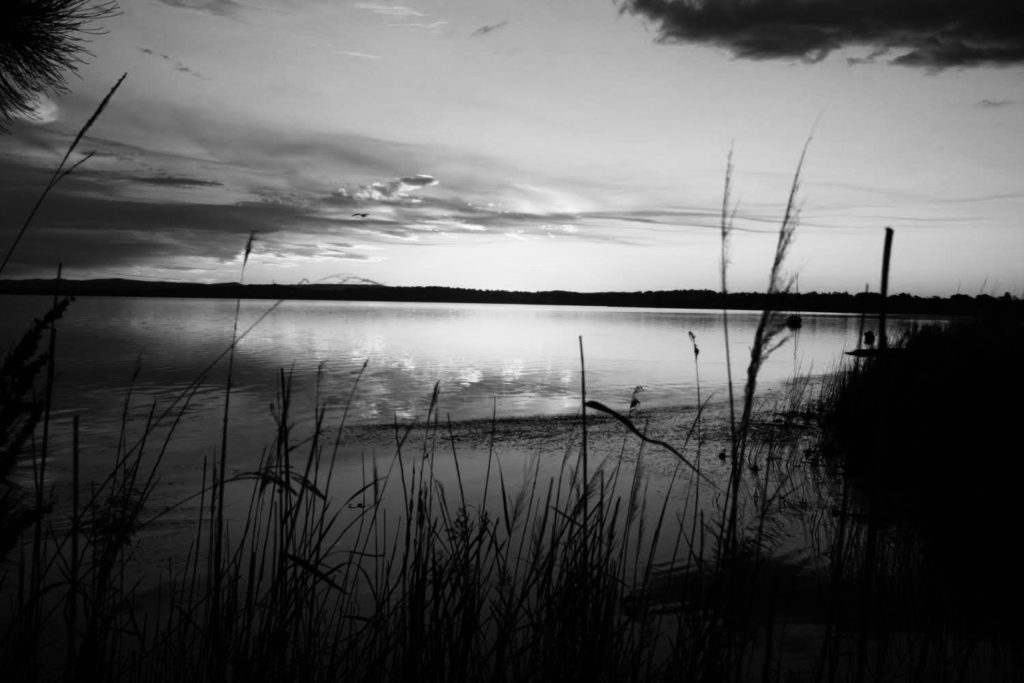
Photo: Sunset over Lake Tuggerah from Canton Beach 4 (Source: Takver | Flickr.com)
Additional Resources
- Hitchhiking Ghost of Wilfred Barrett Drive by Mark Halliday on HubPages
- Jenny Dixon. The Beach, Hitchhiker and Ghost at Hardcore Paranormal
- Australia: The Vengeful Ghost by Virginia Lamkin at Seeks Ghosts
- The Ghost of Jenny Dixon Beach by Chris at Real Unexplained Mysteries
- The Ghost at Jenny Dixon Beach Urban Legend by The Paranormal Guide at Central Coast News
- Press Release: Ghost Hunter and Film Maker Reveal Their Secrets at Tuggerah Library by the Central Coast Council
If you’re enjoying Epitaph, please consider becoming a Patreon patron.
 9 April 2019, 1:00 pm
9 April 2019, 1:00 pm - 1 hour 14 minutesBonus: The Many Ghosts of Blue Bell Hill
Subscribe on your favorite podcast catcher:
Apple Podcasts | Android | CastBox | Google Podcasts | PocketCasts | PodBean | Stitcher | RadioPublic | TuneIn | Blubrry | RSSIn the early morning hours of July 13th, 1974, Maurice Goodenough rushed into the Rochester Police Station in Kent, England. He reported that he’d hit a pedestrian on the A229 while ascending Blue Bell Hill. She’d appeared suddenly in his headlights and, though he’d hit the brakes, it was too late to avoid running into her.
Officers went with Goodenough back to the scene but, though they found the blanket he’d bundled the girl in, were unable to locate the injured girl.
Local media provided an explanation: The girl had to have been a ghost.
This incident was the first to bring widespread attention to the hauntings of Blue Bell Hill.
Digging into the legends, we were quick to discover that the girl that Maurice Goodenough encounters isn’t the only ghost on Blue Bell Hill.
More than fifty recorded sightings that date back to as early as the 1930s tell of frequent and consistent reports of a wide variety of hauntings.
There are reports of pair of female Vanishing Hitchhikers and a girl seen walking quietly beside the road before disappearing. There’s an old woman dressed in a black tartan shawl carrying a bundle of sticks or heather, and a girl on a bicycle. There is a male Vanishing Hitchhiker and, of course, other sightings similar to what Maurice Goodenough encountered.
And, what’s more, many of these reported encounters have real people whose real deaths could have contributed to the lore.
On this episode, we take a look at the Many Ghosts of Blue Bell Hill.
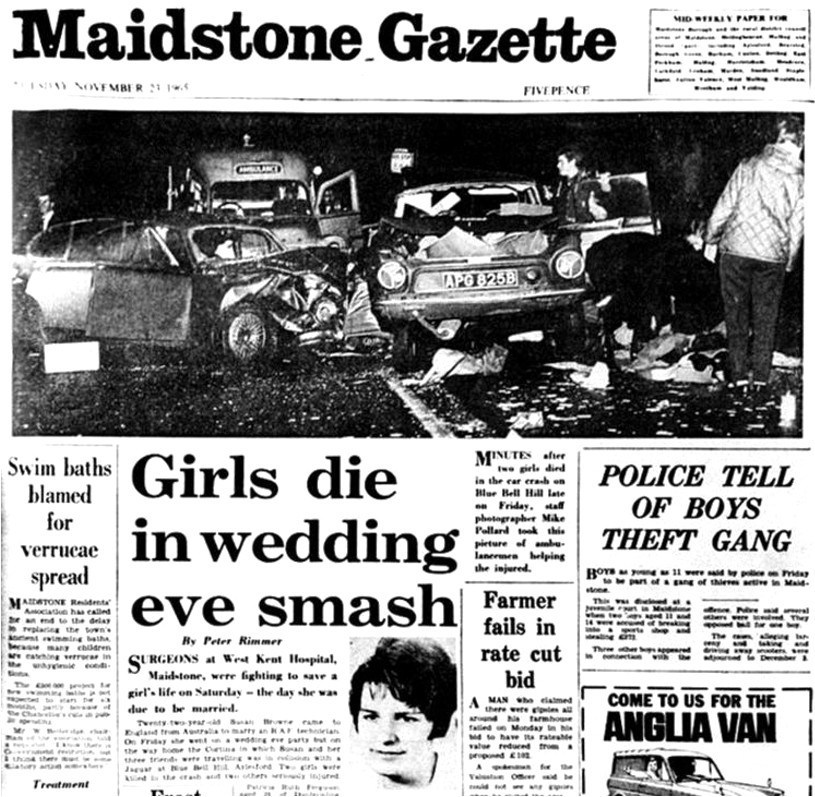
Image: The Maidstone Gazette from Tuesday, November 21, 1974 (Source: The Sun)
Suggested Reading
- The Ghosts of Blue Bell Hill and Other Road Ghosts by Sean Tudor
- The Evidence for Phantom Hitch-Hikers: An Objective Survey of the Vanishing Passenger from Urban Myths to Actual Events by Michael Goss
Additional Resources
- The Ghost of Blue Bell Hill by Sean Tudor
- The Blue Bell Hill Ghost by Brian Haughton
- Blue Bell Hill Ghost, Kent at Haunted Rooms
- Haunted Kent: The Ghosts of Blue Bell Hill by Ann Carney at Exemplore
If you’re enjoying Epitaph, please consider becoming a Patreon patron.
 2 April 2019, 1:00 pm
2 April 2019, 1:00 pm - 6 minutes 29 secondsBonus: The Phantom Fares of Ishinomaki
Subscribe on your favorite podcast catcher:
Apple Podcasts | Android | CastBox | Google Podcasts | PocketCasts | PodBean | Stitcher | RadioPublic | TuneIn | Blubrry | RSSAt 2:46pm on March 11, 2011, a magnitude 9.0 earthquake struck just 80 miles southeast of the Miyagi Prefecture. The quake lasted for six minutes and generated a tsunami that, in some places, reached 133 feet high and travelled more than six miles inland.
The earthquake was so powerful that the entire island of Honshu, Japan’s main island, moved 8 feet closer to the United States.
On the fifth anniversary of the disaster, official records listed 15,893 people dead and an additional 2,572 missing.
In the rubble of Tohoku’s coastal communities, there were reports of spectral figures walking the streets in residential districts where no buildings were left standing and ghosts waiting outside stores the no longer existed.
Today, on the eighth anniversary of the disaster, we remember its victims through the stories told by Japan’s taxi drivers of the Phantom Fares of Ishinomaki.

Photo: A Shinto Torii gate sits atop a hill in Ishinomaki, where more than 3,000 people drowned in the 2011 tsunami. Thousands of others remain missing. Many fled to this hilltop to survive. (Source: NPR)
Additional Resources
- Taxi drivers report ‘ghost passengers’ in area devastated by 2011 tsunami by Hideaki Ishibashi [Archived Link.]
- Talking with the Dead Through Invisible Grief by Wakamatsu Eisuke
“The road to true reconstruction in the disaster-stricken Tōhoku region can be opened by conversing and living together with the dead there. Wakamatsu Eisuke, a literary critic acclaimed for his writings on the living and the dead, holds that talking about the existence of the dead is a must if we are to get on with life in the world after the 3/11 disaster.” - The ghost school of Ishinomaki by Alex Thomson
“Alex Thomson returns to Ishinomaki’s Okawa primary school in Japan, where he finds harrowing reminders of the lives of the 74 children and teachers who died in the tsunami there ...”
If you’re enjoying Epitaph, please consider becoming a Patreon patron.
 11 March 2019, 1:00 pm
11 March 2019, 1:00 pm - 27 minutes 8 secondsThe Lady of White Rock Lake
Subscribe on your favorite podcast catcher:
Apple Podcasts | Android | CastBox | Google Podcasts | PocketCasts | PodBean | Stitcher | RadioPublic | TuneIn | Blubrry | RSSSince the 1930s, White Rock Lake has been a popular recreational area for residents of Dallas, Texas. And, for nearly as long, people have reported seeing the ghost of a woman who’d drowned there..
Some believe that she was the victim of a boating accident. Others suggest that she was in a car accident and that her car wound up in the water.
And, there are certainly plenty of accidents to choose from.
But, the Lady of White Rock Lake isn’t the typical Vanishing Hitchhiker. She’ll ask for a ride, yes. But, she’s also appeared on the front porches of houses near the spot where she’d died, ringing the doorbell and asking to use the telephone.
So, what is her story? Who was the woman — or women — who’d become the Lady of White Rock Lake?
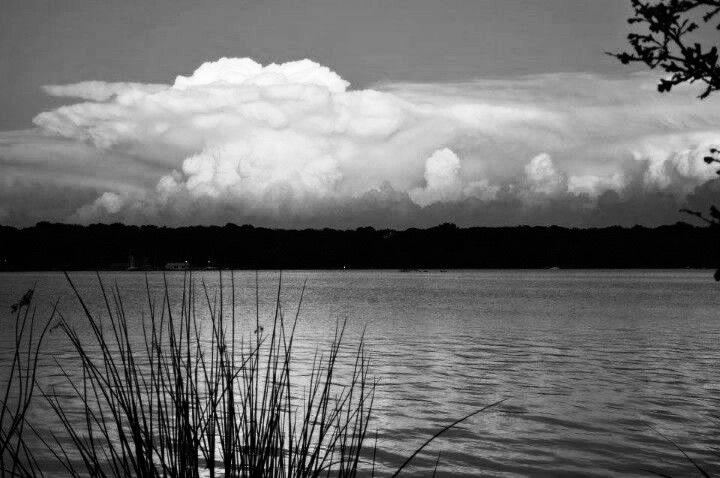
Photo: White Rock Lake, Dallas, Texas by Michael Risser (Source: Pinterest)
Suggested Reading
- Ghost Stories of Texas by Ed Syers
Additional Resources
- The Lady of the Lake at WhiteRockLake.org
- The Lady of the Lake: The Ghost of White Rock Lake by Stephen Butler
If you’re enjoying Epitaph, please consider becoming a Patreon patron.
 5 March 2019, 2:00 pm
5 March 2019, 2:00 pm - 1 hour 21 minutesThe Ghost of 22 Mountain
Subscribe on your favorite podcast catcher:
Apple Podcasts | Android | CastBox | Google Podcasts | PocketCasts | PodBean | Stitcher | RadioPublic | TuneIn | Blubrry | RSSIt was dark and raining.
Clarence Stevenson left his boss’s Ford running when he got out of the car. He quickly looked around to make sure he was alone. Then, he walked around the car, opened the back door and pulled Mamie Thurman’s mutilated corpse from the back seat.
Wrestling it to the side of the road, Clarence grunted as he pushed the body of a woman he’d once considered a friend into a gully and watched it disappear into a bramble of blackberry thorns.
He thought she’d never be seen again.
He was wrong.
For more than eighty-five years, there have continued to be mysterious, unexplainable sightings of Mamie Thurman beside that desolate spot of mountainside highway.
Mamie Thurman’s story is one of scandal, adultery, deception, injustice and brutal murder in the small, coal-mining town of Logan, West Virginia.
Those who know her story will tell you that her murderer was never found, and she’ll continue to walk that lonely road until justice is done.
But, after more than eighty-five years, is there any hope of finding the truth about who was responsible for Mamie Thurman’s death? Or, is the truth just one of many dark secrets buried in the West Virginian soil?

The G.C. Murphy Building. The infamous “Amour Club” met on the second floor.
Suggested Reading
- The Secret Life and Brutal Death of Mamie Thurman by F. Keith Davis
- Ghost of 22 Mountain: The Story of Mamie Thurman by George A. Morrison, Jr.
Additional Resources
- Mamie’s Final Resting Place by Dwight Williamson for the Logan Banner (Archived Link)
- Mamie Thurman story an area ghost legend by Jack Latta for the Williamson Daily News (Archived Link)
- Sex-crazed West Virginia woman, brutally murdered in 1932, may still haunt Appalachia back roads (opens in a new tab)”>Sex-crazed West Virginia woman, brutally murdered in 1932, may still haunt Appalachia back roads by Mara Bovsun for the New York Daily News
If you’re enjoying Epitaph, please consider becoming a Patreon patron.

Photo Gallery
-
 Clarence Stephenson
Clarence Stephenson
-
 Harry Robertson
Harry Robertson
-
 Jack Thurman
Jack Thurman
-
 Mamie Thurman
Mamie Thurman
-
 Stratton Street: The Guyan Valley Bank is on the left.
Stratton Street: The Guyan Valley Bank is on the left.
-
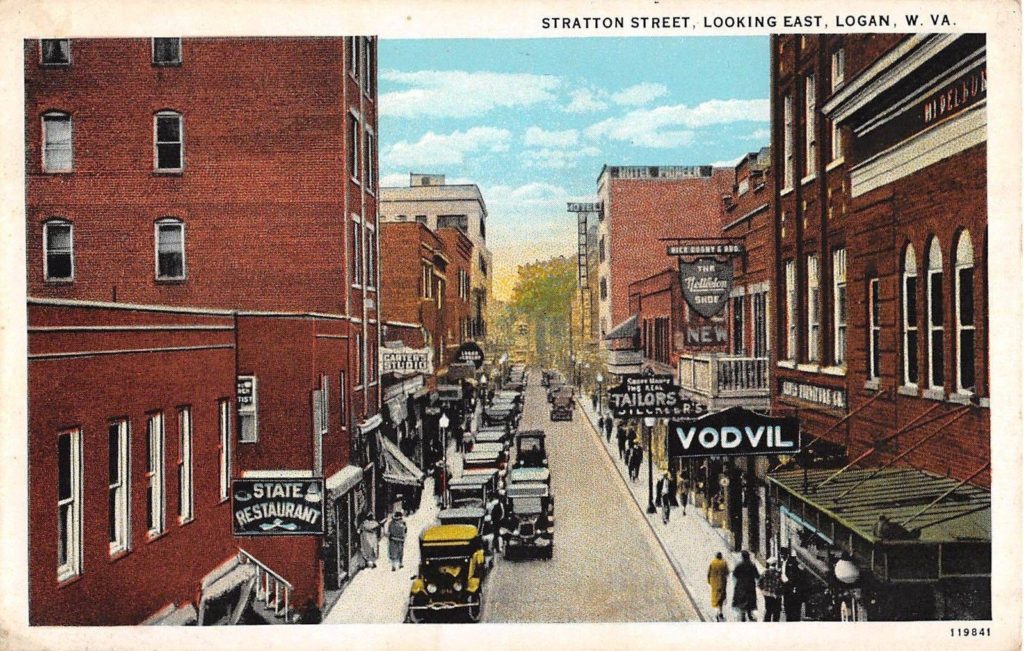 Stratton Street
Stratton Street
-
 The Logan County Courthouse.
The Logan County Courthouse.
The G.C. Murphy Company building, where the infamous
“Amour Club” met on the second floor,is visible on the lower left.
19 February 2019, 2:00 pm - More Episodes? Get the App
Your feedback is valuable to us. Should you encounter any bugs, glitches, lack of functionality or other problems, please email us on [email protected] or join Moon.FM Telegram Group where you can talk directly to the dev team who are happy to answer any queries.
 Over My Dead Body
Over My Dead Body